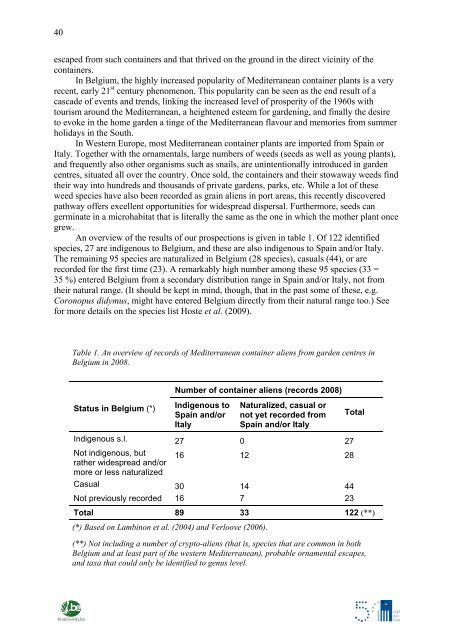Science Facing Aliens - Invasive Alien Species in Belgium - Belgian ...
Science Facing Aliens - Invasive Alien Species in Belgium - Belgian ...
Science Facing Aliens - Invasive Alien Species in Belgium - Belgian ...
Create successful ePaper yourself
Turn your PDF publications into a flip-book with our unique Google optimized e-Paper software.
40<br />
escaped from such conta<strong>in</strong>ers and that thrived on the ground <strong>in</strong> the direct vic<strong>in</strong>ity of the<br />
conta<strong>in</strong>ers.<br />
In <strong>Belgium</strong>, the highly <strong>in</strong>creased popularity of Mediterranean conta<strong>in</strong>er plants is a very<br />
recent, early 21 st century phenomenon. This popularity can be seen as the end result of a<br />
cascade of events and trends, l<strong>in</strong>k<strong>in</strong>g the <strong>in</strong>creased level of prosperity of the 1960s with<br />
tourism around the Mediterranean, a heightened esteem for garden<strong>in</strong>g, and f<strong>in</strong>ally the desire<br />
to evoke <strong>in</strong> the home garden a t<strong>in</strong>ge of the Mediterranean flavour and memories from summer<br />
holidays <strong>in</strong> the South.<br />
In Western Europe, most Mediterranean conta<strong>in</strong>er plants are imported from Spa<strong>in</strong> or<br />
Italy. Together with the ornamentals, large numbers of weeds (seeds as well as young plants),<br />
and frequently also other organisms such as snails, are un<strong>in</strong>tentionally <strong>in</strong>troduced <strong>in</strong> garden<br />
centres, situated all over the country. Once sold, the conta<strong>in</strong>ers and their stowaway weeds f<strong>in</strong>d<br />
their way <strong>in</strong>to hundreds and thousands of private gardens, parks, etc. While a lot of these<br />
weed species have also been recorded as gra<strong>in</strong> aliens <strong>in</strong> port areas, this recently discovered<br />
pathway offers excellent opportunities for widespread dispersal. Furthermore, seeds can<br />
germ<strong>in</strong>ate <strong>in</strong> a microhabitat that is literally the same as the one <strong>in</strong> which the mother plant once<br />
grew.<br />
An overview of the results of our prospections is given <strong>in</strong> table 1. Of 122 identified<br />
species, 27 are <strong>in</strong>digenous to <strong>Belgium</strong>, and these are also <strong>in</strong>digenous to Spa<strong>in</strong> and/or Italy.<br />
The rema<strong>in</strong><strong>in</strong>g 95 species are naturalized <strong>in</strong> <strong>Belgium</strong> (28 species), casuals (44), or are<br />
recorded for the first time (23). A remarkably high number among these 95 species (33 =<br />
35 %) entered <strong>Belgium</strong> from a secondary distribution range <strong>in</strong> Spa<strong>in</strong> and/or Italy, not from<br />
their natural range. (It should be kept <strong>in</strong> m<strong>in</strong>d, though, that <strong>in</strong> the past some of these, e.g.<br />
Coronopus didymus, might have entered <strong>Belgium</strong> directly from their natural range too.) See<br />
for more details on the species list Hoste et al. (2009).<br />
Table 1. An overview of records of Mediterranean conta<strong>in</strong>er aliens from garden centres <strong>in</strong><br />
<strong>Belgium</strong> <strong>in</strong> 2008.<br />
Status <strong>in</strong> <strong>Belgium</strong> (*)<br />
Number of conta<strong>in</strong>er aliens (records 2008)<br />
Indigenous to<br />
Spa<strong>in</strong> and/or<br />
Italy<br />
Naturalized, casual or<br />
not yet recorded from<br />
Spa<strong>in</strong> and/or Italy<br />
Indigenous s.l. 27 0 27<br />
Not <strong>in</strong>digenous, but<br />
rather widespread and/or<br />
more or less naturalized<br />
16 12 28<br />
Casual 30 14 44<br />
Not previously recorded 16 7 23<br />
Total<br />
Total 89 33 122 (**)<br />
(*) Based on Lamb<strong>in</strong>on et al. (2004) and Verloove (2006).<br />
(**) Not <strong>in</strong>clud<strong>in</strong>g a number of crypto-aliens (that is, species that are common <strong>in</strong> both<br />
<strong>Belgium</strong> and at least part of the western Mediterranean), probable ornamental escapes,<br />
and taxa that could only be identified to genus level.


